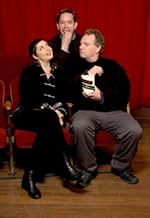The Saddest Music in the World
- 2003
- Tous publics
- 1h 40m
IMDb RATING
7.0/10
6.5K
YOUR RATING
A musical of sorts set in Winnipeg during the Great Depression, where a beer baroness organizes a contest to find the saddest music in the world. Musicians from around the world descend on t... Read allA musical of sorts set in Winnipeg during the Great Depression, where a beer baroness organizes a contest to find the saddest music in the world. Musicians from around the world descend on the city to try and win the $25,000 prize.A musical of sorts set in Winnipeg during the Great Depression, where a beer baroness organizes a contest to find the saddest music in the world. Musicians from around the world descend on the city to try and win the $25,000 prize.
- Director
- Writers
- Stars
- Awards
- 6 wins & 7 nominations total
Nancy Jane Drake
- American Mother
- (as Nancy Drake)
- Director
- Writers
- All cast & crew
- Production, box office & more at IMDbPro
Featured reviews
'The Saddest Music in the World' is a kind of pastiche of 1920s film-making, with interspersed scenes in cod-Technicolour; but to really give a flavour of its oddness, I should say that it's the tale of an amputee brewery heiress with a pair of glass legs, filled up with beer (writer Kazuo Ishiguro borrowing from one of his own novels in the story of how she lost her originals). In truth, this is a very silly film, but it's almost a triumph, in that the silliness is controlled, with every crazy scene is consistent in tone and adding to the bizarre atmosphere. But it's hard to assert that the movie amounts to much more than a demonstration that it was technically possible to make it - it can't be taken seriously, and it's not really funny (rather, it's the sort of film that only makes you laugh because of its audaciousness in what it dares to pass off as comedy). But you certainly won't see too many other movies like it; and director Guy Maddin makes brilliant use of the heart-shaped face of Maria de Madeiros, which he makes look as if it really has just heard the saddest music ever.
And I thought `Dogville' was stylized. Canadian writer/director Guy Maddin ("Dracula: Pages from a Virgin's Diary,' "Archangel') has created a film like no other this year except possibly `Triplet's of Belleville.' `The Saddest Music in the World' is a `musical' set in Winnipeg in 1933, where Lady Port-Huntly (Isabella Rossellini) is holding a contest to award $25,000 to the saddest music performer. In `Depression Era dollars,' no less.
Winnipeg has been declared by the London Times `the world capital of sorrow' for the fourth year in a row. What happens in the film can be categorized as surrealism of the sort that marries the Melies brothers in their `Trip-to-the-Moon' wackiest to `The Twilight Zone' in Rod Serling's most hilarious (and that's pretty unusual) moments. Shot in distressed mode with 8 mm blown up to be grainy and silent movieish, `Saddest' has blue-grays and silvers and occasional bursts of washed-out color that give it an otherworldly cast meant to satirize the old movies and create a new look built on nostalgia and freedom from convention that some call expressionism.
Some of the bizarre acts vying for the prize are Fyodor (David Fox), a veteran of World War I representing Canada, who plays a deathlike version of ''The Red Maple Leaves'' on an upright piano he has turned over, and Indian singers in Eskimo costumes, who dance to ''California Here I Come'' with sitars and banjos commemorating a 19th-century kayaking accident. All the time an iris lens blurs the edges of the film to recreate the ancient look of film found in a vault after 50 years.
That Lady Port-Huntly needs artificial legs is not as bizarre as the back story of how she came to need them, and that the new glass legs have local beer coursing through them is just another creative and absurdist touch. With a resemblance to the robot in `Metropolis,' she is an amalgam of strange and prophetic moments in film and culture. I know I'm not making much sense here-Trust me that this film is bizarre enough to satisfy the geekiest cultist in our audience. For the rest of us, just trying to appreciate all the signposts Maddin constructs to further his absurd and funny vision is exhausting. Wordsworth's thoughts apply because we at least hear `the still, sad music of humanity.'
Winnipeg has been declared by the London Times `the world capital of sorrow' for the fourth year in a row. What happens in the film can be categorized as surrealism of the sort that marries the Melies brothers in their `Trip-to-the-Moon' wackiest to `The Twilight Zone' in Rod Serling's most hilarious (and that's pretty unusual) moments. Shot in distressed mode with 8 mm blown up to be grainy and silent movieish, `Saddest' has blue-grays and silvers and occasional bursts of washed-out color that give it an otherworldly cast meant to satirize the old movies and create a new look built on nostalgia and freedom from convention that some call expressionism.
Some of the bizarre acts vying for the prize are Fyodor (David Fox), a veteran of World War I representing Canada, who plays a deathlike version of ''The Red Maple Leaves'' on an upright piano he has turned over, and Indian singers in Eskimo costumes, who dance to ''California Here I Come'' with sitars and banjos commemorating a 19th-century kayaking accident. All the time an iris lens blurs the edges of the film to recreate the ancient look of film found in a vault after 50 years.
That Lady Port-Huntly needs artificial legs is not as bizarre as the back story of how she came to need them, and that the new glass legs have local beer coursing through them is just another creative and absurdist touch. With a resemblance to the robot in `Metropolis,' she is an amalgam of strange and prophetic moments in film and culture. I know I'm not making much sense here-Trust me that this film is bizarre enough to satisfy the geekiest cultist in our audience. For the rest of us, just trying to appreciate all the signposts Maddin constructs to further his absurd and funny vision is exhausting. Wordsworth's thoughts apply because we at least hear `the still, sad music of humanity.'
I spent the whole time asking myself whether I was enjoying this. I tried, but I'm still not sure. I did appreciate the film making. The director clearly asked 'what can we do with the camera?' and the answer was 'anything'. There were many beautiful shots that had me hitting the pause button. A lot of it had an experimental feel - but that wasn't the problem. The story, based on an original screenplay by Kazuo Ishiguro (perhaps they should have stuck to the original), felt like it was concocted by different people trying to outdo each other with silly ideas (tapeworms, beer-filled glass legs, sleeping in the snow, a character based on Gavrilo Princip - you quickly stopped asking why) - but that wasn't the problem either.
The film might have been a collaboration between David Lynch, Orson Welles, Eisenstein, and the Brothers Quay - each of them disagreeing what the film should be about. It was worth trying. I quickly got used to the extremely smudgy effect - as if the lens had been smothered in vaseline - and I appreciated Isabella Rosselini (looking and sounding like her mother) and the big-eyed Maria de Madeiros.
The backdrop was a music contest between international contestants to find the world's saddest music. The face-off heats was pure Python but it was all kept strangely distant. There were several problems: the emotional drama between the father and the two sons was dreary, as such issues always are. Secondly, it wasn't funny, and that was because it was all art and no emotional intelligence. Thirdly, it said nothing. It was full of ideas, but they were all microscopic, worked out at scene level - or even frame level. The whole thing put together didn't add up to anything. In the end, the images were everything, and that is always going to be disappointing.
The film might have been a collaboration between David Lynch, Orson Welles, Eisenstein, and the Brothers Quay - each of them disagreeing what the film should be about. It was worth trying. I quickly got used to the extremely smudgy effect - as if the lens had been smothered in vaseline - and I appreciated Isabella Rosselini (looking and sounding like her mother) and the big-eyed Maria de Madeiros.
The backdrop was a music contest between international contestants to find the world's saddest music. The face-off heats was pure Python but it was all kept strangely distant. There were several problems: the emotional drama between the father and the two sons was dreary, as such issues always are. Secondly, it wasn't funny, and that was because it was all art and no emotional intelligence. Thirdly, it said nothing. It was full of ideas, but they were all microscopic, worked out at scene level - or even frame level. The whole thing put together didn't add up to anything. In the end, the images were everything, and that is always going to be disappointing.
I had always been told that director Guy Maddin did nothing conventionally, and so I approached The Saddest Music in the World with anticipation and hesitation. I am a great fan of Isabella Rossellini and Maria de Medeiros, both of whom do well in this picture. Maddin delivers a picture that is quite beautiful visually; all in black and white, and edited in such a way as to recall something resurrected from the 1930s. There are a few occasions when colour is allowed in, and those moments dazzle. One of the most striking images I have seen all year is Isabella Rossellini posing in Technicolour standing on glass legs filled with beer. It's something that has to be seen to be believed. However, once you get past the visuals, the film is rather empty and lacks heart. I do recommend it, though, because everyone should see something new and different (and for Isabella and Maria).
Don't be scared away by people who warn that this movie is too difficult or bizarre. This film will appeal to more than just the usual cabal of obscurantists and nerdy cultists. The plot is quite straightforward: a depression-era beer baroness commissions a contest whose aim it is to find the saddest music in the world. As a result, scores of zany musicians from around the world descend on frost-bitten Winnipeg to win a $25000 prize. Hilarity ensues.
That's not to say the movie doesn't have its fair share of the absurd, the bizarre, and the dark (it *is* a Canadian film, after all). Lines are delivered with strange inflections, characters' motivations are screwy, filmic styles are mixed. None of these, however, comes off as pretentious or forced.
The film explores the interesting paradox that despite the reality and ubiquity of real sadness, authentic expressions of sadness are difficult and rare.
That's not to say the movie doesn't have its fair share of the absurd, the bizarre, and the dark (it *is* a Canadian film, after all). Lines are delivered with strange inflections, characters' motivations are screwy, filmic styles are mixed. None of these, however, comes off as pretentious or forced.
The film explores the interesting paradox that despite the reality and ubiquity of real sadness, authentic expressions of sadness are difficult and rare.
Did you know
- TriviaSome actors are given an "additional camera" credit, as they shot footage on handheld Super8 cameras.
- Quotes
Lady Port-Huntley: If you are sad and like beer, I'm your lady.
- SoundtracksThe Song is You
Music by Jerome Kern
Lyrics by Oscar Hammerstein II
Used by permission of Universal - Polygram International Publishing, Inc.
- How long is The Saddest Music in the World?Powered by Alexa
Details
- Release date
- Country of origin
- Languages
- Also known as
- La canción más triste del mundo
- Filming locations
- Production companies
- See more company credits at IMDbPro
Box office
- Budget
- CA$3,500,000 (estimated)
- Gross US & Canada
- $699,225
- Opening weekend US & Canada
- $37,743
- May 2, 2004
- Gross worldwide
- $854,994
- Runtime
- 1h 40m(100 min)
- Color
- Sound mix
- Aspect ratio
- 1.85 : 1
Contribute to this page
Suggest an edit or add missing content
































